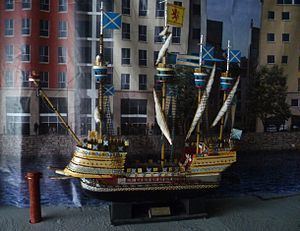Completed 18 February 1512 Length 73 m Launched 12 October 1511 | Ordered c.1505 Laid down 1507 Construction started 1507 | |
 | ||
Michael, popularly known as Great Michael, was a carrack or great ship of the Royal Scottish Navy. She was the largest ship built by King James IV of Scotland as part of his policy of building a strong Scottish navy.
She was ordered around 1505 and laid down in 1507 under the direction of Captain Sir Andrew Wood of Largo and the master shipwright Jacques Terrell, launched on 12 October 1511 and completed on 18 February 1512. She was too large to be built at any existing Scottish dockyard, so was built at the new dock at Newhaven. When Michael was launched she was the largest ship afloat, with twice the original displacement of her English contemporary Mary Rose, which was launched in 1509 and completed in 1510.
The poet William Dunbar wrote of her construction:
Translation:
The chronicler Lindsay of Pitscottie wrote of the building of Michael that "all the woods of Fife" went into her construction. Account books add that timbers were purchased from other parts of Scotland, as well as from France and the Baltic Sea. Lindsay gives her dimensions as 240 feet (73 m) long and 35 ft (11 m) in beam. Russell (1922) notes that Michael was supposed to have been built with oak walls 10 ft (3.0 m) thick. She displaced about 1,000 tons, had four masts, carried 24 guns (purchased from Flanders) on the broadside, 1 basilisk forward and 2 aft, and 30 smaller guns (later increased to 36 main guns), and had a crew of 300 sailors, 120 gunners, and up to 1,000 soldiers.
Henry VIII of England was unwilling to be outdone, and ordered the building of the 1000-ton Henri Grâce à Dieu, launched in roughly 1512, later known as Great Harry, which was even larger. These ships were the first great ships, the precursors of the later ship of the line.
Michael was named after the archangel Michael and built to support a Scottish crusade against the Ottoman Empire to reclaim Palestine for Christendom. This grandiose plan had to be changed when the commitments of the Auld Alliance with France required Scotland to go to war with England, to divert England from her war with Louis XII of France (see the Italian Wars).
In August 1513 a Scottish invasion force was assembled to attack English possessions in France. Commanded by James Hamilton, 1st Earl of Arran, the chief ships were Michael, Margaret and James. Instead of attacking the English, Arran raided Carrickfergus in Ireland and returned with loot before proceeding to France.
A warship of this size was costly to maintain, particularly for a small country like Scotland. Michael was hired by France in late August 1513. After James IV and many of the nobility of Scotland were killed at the Battle of Flodden in September 1513, Michael was sold to Louis XII of France on 2 April 1514 for the bargain price of 40,000 livres and became known as "La Grande Nef d'Ecosse" (The Big Nave of Scotland) (Nave is from the medieval Latin navis, meaning 'ship'). In March 1514 Michael was reported to be docked at Honfleur because she was too big for the harbour at Dieppe. Most historians have accepted the account of the Scottish historian George Buchanan that after this, the French allowed her to rot at Brest. Norman MacDougall in 1991 suggested that under her new French name, she may have been used in the French attack on England in 1545 that led to the sinking of the English warship Mary Rose in the Battle of the Solent on 19 July 1545.
